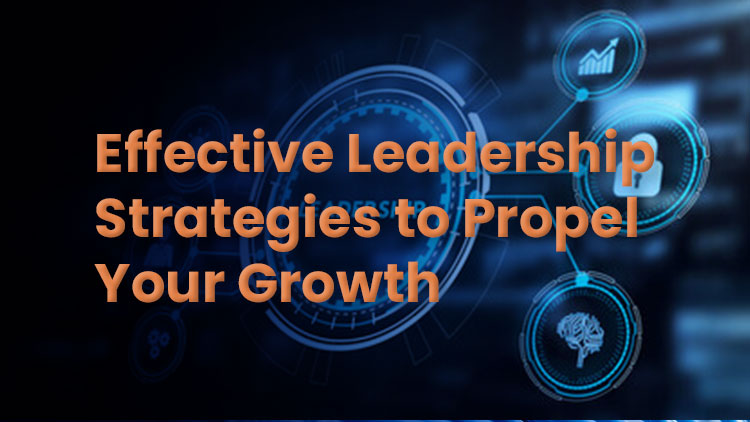
Effective Leadership Strategies to Propel Your Growth


Looking to unlock the secrets to business growth and long-term success? Well, it all boils down to one key player: leadership. Impressive leaders not only inspire their teams but also mastermind strategic decisions that shape the company’s destiny. And that’s not all—they’re the architects behind a culture that radiates positivity throughout the organization.
So, what’s this article about? We’re diving deep into the thrilling world of leadership and its colossal impact on business growth and triumph. Get ready to unravel the traits that set exceptional leaders apart, witness how they turbocharge employee engagement and productivity, and even snag some insider tips on fostering top-notch leadership within your own organization. Let’s embark on this exhilarating leadership journey!
How Effective Leaders Propel Organizational Success
Effective leaders act as the driving force behind organizational success, steering their teams toward greatness. They possess a unique blend of qualities: they’re visionaries, capable of charting a clear path forward; they’re motivators, inspiring and empowering their teams to exceed expectations. These leaders aren’t just about making decisions—they’re about making the right decisions, utilizing their strategic prowess to navigate challenges and capitalize on opportunities. Moreover, they foster an environment of collaboration and open communication, where every individual feels valued and motivated to contribute their best. By setting high standards, encouraging innovation, and adapting swiftly to changes, effective leaders create a culture that propels the organization toward its goals and ensures sustained success in the long run.
Ready to take a thrilling journey into the world of dynamic leadership? Let’s learn what defines successful leadership growth and how it shapes organizational triumph!
6 Key Strategies to Achieve Leadership Brilliance
In the business realm, leaders aren’t just figureheads; they’re the driving force behind success. They’re akin to captains steering ships through uncharted waters, setting the stage for growth, navigating challenges, and empowering their teams.
Do you aspire to be a leader known to break barriers, showcasing visionary thinking, strategic decision-making, effective communication, and a dedication to continual learning? Let’s have a look at strategies that form the bedrock of leadership brilliance, guiding leaders toward sustained success in the ever-evolving landscape of business.
#1. Pioneering the Expedition for Growth
Imagine leaders as these visionaries with a crystal-clear picture of where their company is headed. They don’t just see it; they paint that vision for their teams, firing them up toward common goals.
The key to smart leadership is grasping how to lead with strategic vision and setting clear goals. It’s like handing out purpose on a platter and fueling business growth like never before.
Example:
Elon Musk, CEO of SpaceX and Tesla, exemplifies visionary leadership by painting a clear picture of the future. At SpaceX, Musk’s vision for colonizing Mars fired up the team, leading to groundbreaking achievements in space exploration. Similarly, at Tesla, his mission to accelerate sustainable energy adoption ignited innovation, propelling the company to the forefront of electric vehicles. Musk’s ability to inspire teams with a vivid vision showcases how visionary leaders fuel business growth by instilling purpose and direction.
#2. Strategic Decision-Making: Surfing Waves and Scaling Mountains
Have you ever wondered what successful leaders prioritize?
Leadership isn’t just about calling the shots; it’s about calling the right ones. As a leader, you must learn to pick your battles correctly. Great leaders don’t just ride market trends; they create them. They’re like chess players, always a step ahead, positioning their organization for growth while gracefully navigating through rough patches.
Example:
Reed Hastings, Netflix’s co-founder and CEO, anticipated the digital revolution in entertainment during the early 2000s. While Netflix primarily rented DVDs by mail, Hastings redirected the company toward online streaming, investing in original content. This strategic shift transformed Netflix into a global streaming giant, reshaping entertainment consumption and surpassing traditional television. Hastings’ foresight and proactive approach didn’t just follow trends; it shaped the future of entertainment, positioning Netflix for remarkable growth and highlighting how visionary leaders create industry trends.
#3. Energizing Teams: Powering Up the Engines
Think of these leaders as the ultimate team cheerleaders. They don’t just manage; they empower, inspire, and celebrate their team’s wins. By creating a workplace where trust and growth thrive, they’re basically boosting the company’s heartbeat, driving engagement, and turbocharging productivity.
Example:
Mary Barra, CEO of General Motors, exemplifies energizing leadership. Facing challenges upon taking the helm, Barra fostered a culture of trust and innovation. She encouraged open communication, empowering teams to voice ideas and drive innovation. Under her guidance, GM embraced electric and autonomous vehicles, celebrating wins and nurturing a culture of continuous improvement. Barra’s leadership revitalized GM, boosting morale, driving engagement, and showcasing how empowering teams fuel organizational success.
#4. Cultivating Dream Teams: Unleashing Superpowers
Leadership isn’t about assembling a group; it’s about crafting a dream team. Picture leaders as talent scouts, spotting strengths and talents, mixing and matching to create this powerhouse squad. And when this diverse, inclusive team clicks, innovation rockets, productivity soars, and the business skyrockets.
Example:
Steve Jobs, during the creation of the iPhone at Apple, showcased the art of cultivating dream teams. He handpicked a diverse group of experts who shared a vision for revolutionizing mobile technology. Jobs encouraged collaboration, valuing diverse perspectives. This powerhouse team’s synergy led to the groundbreaking innovation of the iPhone, highlighting how assembling the right mix of talents drives unparalleled success.
#5. Stellar Communication: Harmonizing the Orchestra
Ever seen a leader who can speak, and suddenly, everyone’s marching to the same beat? That’s the magic of effective communication. They paint the big picture, setting everyone’s compass in the right direction. With open, clear communication, they ensure everyone’s on the same page, singing the company’s anthem. This is what sets impactful leaders apart.
Example:
Oprah Winfrey’s influential communication style, evident in her renowned talk show, “The Oprah Winfrey Show,” showcased her ability to engage audiences authentically. She used her platform to discuss diverse societal issues, promoting empowerment and positive change. Beyond the show, Winfrey’s impactful communication extended to advocacy for education and philanthropy, emphasizing the transformative influence of effective leadership communication.
#6. Lifelong Learning: The Quest for Leadership Mastery
Picture leaders as eternal learners on an epic quest. They aren’t just leaders; they’re students, constantly honing their skills and encouraging their teams to do the same. By embracing the power of knowledge, they’re future-proofing themselves and their organizations for continued triumph.
Example:
Jack Ma, the co-founder of Alibaba Group, epitomizes lifelong learning. Despite early setbacks, Ma’s commitment to self-improvement persisted. He fostered a culture of innovation at Alibaba, emphasizing continual learning and adapting to change. Even after achieving success, Ma remained dedicated to education and shared his insights globally, demonstrating how a thirst for knowledge drives personal growth and inspires leadership excellence.
How to Implement Effective Leadership Strategies
Okay! Now that we know the strategies, how do we implement them?
Implementing effective leadership strategies requires a deliberate and thoughtful approach aimed at empowering teams, fostering growth, and achieving shared goals. Here are some leadership development and growth tips:
- Understanding your team
- Set a clear vision and goal
- Empower and delegate
- Encourage open communication
- Enforce a continuous learning culture
- Lead by example
- Implement adaptability and flexibility
- Acknowledge and support
- Monitor progress and adjust
- Celebrate successes
Implementing effective leadership strategies is an ongoing process that requires dedication, empathy, and a genuine commitment to supporting and empowering your team. Do you have what it takes to foster leadership success? Simply customize these strategies to your team’s unique dynamics, and continuously refining them will drive long-term success and growth within your organization.
Final Thoughts
Now that we have seen examples of leadership excellence and how to achieve it, it is up to you to implement these effective leadership techniques for growth.
Remember, leadership excellence isn’t a destination; it’s a continuous pursuit. Embrace these principles, adapt them to your unique context, and lead with purpose, empathy, and a commitment to growth. As you journey through your leadership path, keep in mind that great leadership isn’t solely about achieving success; it’s about inspiring and enabling others to succeed along with you.
- Published Date:



